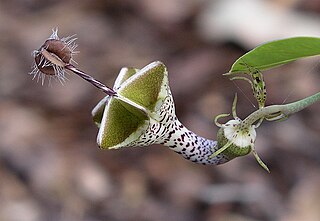
Ceropegia is a genus of plants within the family Apocynaceae, native to Africa, southern Asia, and Australia. It was named by Carl Linnaeus, who first described this genus in his Genera plantarum, which appeared in 1737. Linnaeus referred to the description and picture of a plant in the Horti Malabarici as the plant for which the genus was created. In 1753 he named this species as Ceropegia candelabrum. Linnaeus did not explain the etymology but later explanations stated that the name Ceropegia was from the Greek word keropegion κηροπηγɩον. This means candelabrum in Latin, which has a broader range than the modern word - "a candlestick, a branched candlestick, a chandelier, candelabrum, or also lamp-stand, light-stand, sometimes of exquisite workmanship".

Macizo de Anaga is a mountain range in the northeastern part of the island of Tenerife in the Canary Islands. The highest point is 1,024 m. It stretches from the Punta de Anaga in the northeast to Cruz del Carmen in the southwest. Anaga features the mountain peaks of Bichuelo, Anambro, Chinobre, Pico Limante, Cruz de Taborno and Cruz del Carmen. The mountains were formed by a volcanic eruption about 7 to 9 million years ago making it the oldest part of the island. Since 1987 it has been protected as a "natural park", reclassified as "rural park" in 1994. Since 2015 it is also an UNESCO Biosphere Reserve and is the place that has the largest number of endemic species in Europe.
Murlen National Park is a national park located in the Champhai district Mizoram in India. The size of the park area is 200 km2 (77 sq mi). The park is situated about 245 km east of Aizawl, and is close to the Chin Hills. It lies north of Lengteng Wildlife Sanctuary in the same district. It covers an area of approximately 100 km2. The tropical, semi-evergreen and sub montane Forests of Murlen are home to a rich variety of flora and fauna. About 15 species of mammals, 150 species of birds, 35 species of Medicinal plants, 2 species of bamboos, and 4 species of orchids so far have been recorded in this Park. In 2012, 36 people were involved in conservation work of Murlen National Park.

Ceropegia woodii is a flowering plant in the dogbane family Apocynaceae, native to South Africa, Eswatini and Zimbabwe. It is sometimes treated as a subspecies of the related Ceropegia linearis, as C. linearis subsp. woodii. Common names include chain of hearts, collar of hearts, string of hearts, rosary vine, hearts-on-a-string, and sweetheart vine.

Ceropegia fusca is a flowering plant in the genus Ceropegia (Apocynaceae). It is endemic to the Canary Islands, where it grows on Tenerife, Gran Canaria, and La Palma in the Tabaibal-Cardonal zone at up to about 600 m altitude.

Ceropegia stapeliiformis is a flowering plant in the genus Ceropegia (Apocynaceae), native to South Africa and Eswatini. Common names include serpent ceropegia, snake creeper, and slangkambro.
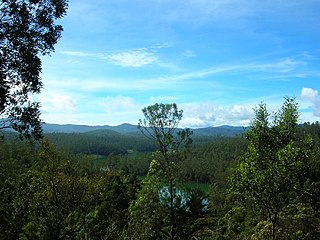
The Nilgiri Mountains form part of the Western Ghats in northwestern Tamil Nadu, Southern Karnataka, and eastern Kerala in India. They are located at the trijunction of three states and connect the Western Ghats with the Eastern Ghats. At least 24 of the Nilgiri Mountains' peaks are above 2,000 metres (6,600 ft), the highest peak being Doddabetta, at 2,637 metres (8,652 ft).
Ceropegia dinteri is a species of plant in the family Apocynaceae. It is endemic to Namibia. Its natural habitats are subtropical or tropical dry shrubland and rocky areas.

Ceropegia sandersonii is a species of flowering plant in the family Apocynaceae that is native to Mozambique, South Africa, and Eswatini. Common names are parachute plant, fountain flower, and umbrella plant.

Ceropegia elegans is a plant species that belongs to the genus Ceropegia. It is endemic to India and Sri Lanka.
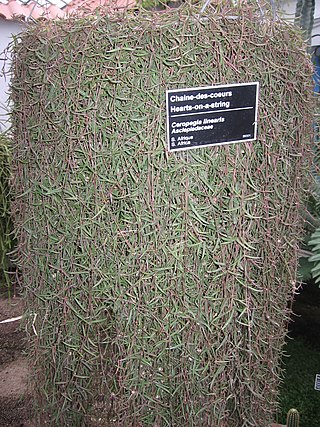
Ceropegia linearis is a species of flowering plant in the family Apocynaceae, native to Southern Africa.
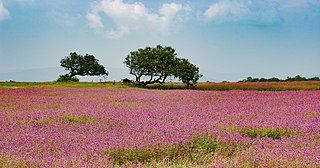
The Kas Plateau Reserved Forest, also known as the Kaas Pathar, is a plateau situated 25 kilometres west from Satara city in Maharashtra, India. It falls under the Sahyadri Sub Cluster of the Western Ghats, and it became a part of a UNESCO World Natural Heritage Site in 2012.

Ceropegia candelabrum is the type species in its genus of plants, belonging the subfamily Asclepiadoideae. The Latin specific epithet candelabrum is derived from the candelabra-like appearance of the inflorescences.
Ceropegia huberi is a species of plant in the family Apocynaceae.
Ceropegia anjanerica is a species of flowering plant in the family Apocynaceae. Flowers are 2.5-3.5 cm long, usually slightly curved and greenish yellow in color and the plants are up to 20cm high. It is endemic to the Anjaneri Hills area of Nashik district.

Ceropegia radicans is a species of herb in the family Apocynaceae. The leaves are fleshy and glabrous and it has a large cage-like flower with a slender tube swollen at the base, and divided into five segments at the top. It grows up to 20cm in height.
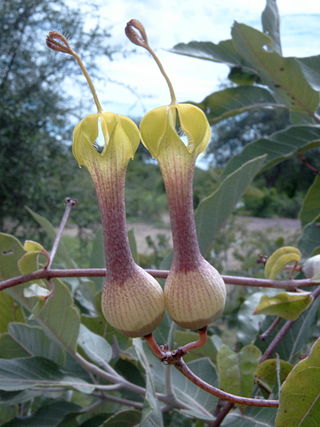
Ceropegia rhynchantha is a species of plants in the family Apocynaceae. It occurs in West Africa and has slender flowers, with basal inflation and slight expansion of the tube towards the mouth, as well as relatively long, narrow lobes.

Ceropegia jainii is a species of flowering plant in the family Apocynaceae.














